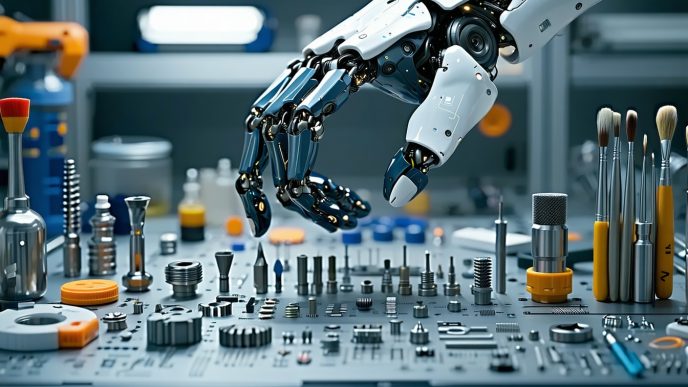Robot Gripping and Manipulation
The Importance of Grasping Technology in Robotics
Grasping technology is a fundamental component of robotics, as it enables robots to effectively interact with and manipulate various objects in their environment. The ability to pick up, hold, and move items is crucial for robots, especially in applications such as manufacturing, healthcare, and domestic tasks. Advanced robot grasping technology enhances the versatility of robotic systems, allowing them to perform complex operations with precision and safety.
Understanding how robots create secure grips is essential, as improper handling can lead to damaged objects or equipment. This technology also incorporates elements such as gripping strength in robots and the stability of the grasping mechanism. As robotics advancements continue, the integration of sophisticated algorithms and sensory feedback into grasping methods is becoming increasingly vital.
Overview of How Robots Pick Up Objects
Robots employ a variety of techniques and technologies to pick up objects. The grasping process generally involves several steps:
-
Detection: The robot utilizes sensors to identify and locate the target object. This may involve vision systems or depth sensors to provide spatial awareness and object dimensions.
-
Approach: Once an object is detected, the robot positions itself optimally to facilitate grasping. This may include navigating around obstacles or adjusting its angle for better access.
-
Gripping: The robot uses a gripper designed for specific tasks, which may include compliant grippers or more rigid designs depending on the object’s nature. Parameters such as shape and weight of the object are taken into account.
-
Tactile Feedback: During the gripping process, robots often rely on tactile sensors to monitor the grip’s effectiveness. This feedback informs adjustments needed to prevent slipping or crushing the object. For more on sensory technology, see our article on tactile sensors in robot hands.
-
Manipulation: After successfully grasping the object, the robot can manipulate it according to programed tasks, whether it’s moving items on an assembly line or performing intricate operations in settings such as healthcare or service sectors.
The table below illustrates the various components involved in the robot grasping process:
| Step | Description |
|---|---|
| Detection | Identifying and locating the object |
| Approach | Positioning the robot for optimal grasping |
| Gripping | Engaging the object with appropriate gripper type |
| Tactile Feedback | Monitoring grip effectiveness and making adjustments |
| Manipulation | Performing tasks with the grasped object |
Through the integration of advanced adaptive gripping in robots and effective handling strategies, robots can engage in a wide range of robot manipulation tasks, showcasing the importance of robust grasping technology in the field of robotics.
Robot Grippers
Robot grippers are essential components in the field of robotics, enabling machines to interact with their environment effectively. Understanding the types of grippers and their mechanisms offers insights into the capabilities of robots in grasping and manipulating various objects.
Types of Grippers Used in Robotics
Different types of grippers are designed to meet various requirements in robotic applications. The following table summarizes some of the most common gripper types used in robotics:
| Gripper Type | Description | Applications |
|---|---|---|
| Parallel Grippers | Utilizes two parallel fingers to grasp objects. | Assembly, packaging, and material handling. |
| Three-Finger Grippers | Features three fingers that provide a more stable grip. | Handling irregularly shaped objects. |
| Vacuum Grippers | Uses suction to pick up flat or smooth items. | Lifting glass, cardboard, or other flat surfaces. |
| Soft Grippers | Made from flexible materials to adapt to various shapes. | Picking up delicate or irregularly shaped items. |
| Magnetic Grippers | Employs magnets to secure ferromagnetic objects. | Manufacturing and warehousing tasks. |
Each type of gripper has its unique strengths, allowing robots to perform specific functions such as those found in robot manipulation tasks across industries.
Mechanisms of Robot Grippers
The mechanisms behind robot grippers dictate how they operate and interact with objects. Common mechanisms include:
-
Mechanical Linkages: These systems utilize a series of levers and links to create motion in the gripper. This design is typically used in parallel and three-finger grippers.
-
Pneumatics: Pneumatic grippers rely on air pressure to create movement, providing a strong grip. They are often used in industrial applications for their fast action and powerful grip.
-
Electromagnetic Systems: Grippers using this mechanism incorporate electromagnets, which are especially effective in settings where handling metallic objects is frequent.
-
Shape Memory Alloys: This technology uses metals that change shape in reaction to temperature variations, offering responses that can adapt to varying object shapes.
-
Soft Robotics: Utilizing flexible materials, soft grippers can conform to the object’s shape, which is beneficial for delicate handling.
Mechanisms of grippers often take into account the necessary gripping strength in robots to handle different object weights and textures. The integration of tactics for gripping and manipulation is a vital area of study within robot grasping technology. By exploring diverse types and mechanisms, robotic systems can be optimized for a wide array of tasks, ensuring versatility and efficiency in their operations.
Compliant Gripping
Compliant gripping is an advanced technique in the field of robotics that allows robots to interact with objects more gently and effectively. Understanding this technology is crucial for those interested in how robots handle different tasks and the challenges associated with robot grasping.
Understanding Compliant Grippers
Compliant grippers are designed to adapt their shape and exert varying forces on the objects they grasp. Unlike rigid grippers, compliant grippers can conform to the shape of the object being manipulated, which enhances their ability to handle fragile or irregularly shaped items. This is especially significant in applications where precision and care are necessary.
A compliant gripper usually consists of the following components:
| Component | Description |
|---|---|
| Actuators | Devices that enable movement |
| Sensors | Devices that detect contact and pressure |
| Materials | Flexible materials that provide compliance |
| Control System | Software that manages the gripping actions |
Benefits of Compliant Gripping in Robotics
The advantages of compliant gripping technology are numerous and impactful:
-
Reduced Damage to Objects: By applying just the right amount of force, compliant grippers can prevent potential damage to delicate items, making them ideal for tasks involving fragile objects.
-
Increased Versatility: Compliant grippers can handle a wider variety of shapes and sizes due to their adaptable nature. This enables robots to perform more complex robot manipulation tasks and complete tasks that would be challenging for traditional rigid grippers.
-
Improved Safety: The ability to adjust grip strength helps in preventing accidents, both for the objects being handled and the environment. Robots using compliant gripping are less likely to drop or crush items inadvertently.
-
Enhanced Dexterity: Compliant grippers can mimic the motions of human hands, allowing robots to execute tasks that require a high level of dexterity. This is particularly relevant in fields like dexterous robot hands, where fine manipulation is essential.
| Benefit | Description |
|---|---|
| Reduced Damage | Minimizes risk of harming fragile items. |
| Increased Versatility | Ability to handle various shapes and sizes. |
| Improved Safety | Lower chance of accidents during manipulation. |
| Enhanced Dexterity | Greater flexibility in performing tasks that require fine movements. |
Compliant grippers represent a significant advancement in robot grasping technology, positioning robots for better interaction with diverse environments and tasks. Understanding the mechanics and benefits of these grippers enhances awareness of the ongoing developments in robotic manipulation and the potential applications in various industries.
Vision Systems in Grasping
Understanding how robots grasp objects involves recognizing the vital role of vision systems. These technologies enable robots to detect, identify, and interact with their surroundings, making them essential for effective robot grasping technology.
Role of Vision Systems in Object Detection
Vision systems provide robots with the ability to “see” their environment. Using cameras and sensors, these systems gather visual data about objects, allowing robots to assess size, shape, and positioning. The data collected is critical for successful manipulation tasks, as the robot must know precisely what it is handling.
| Vision System Type | Functions | Typical Applications |
|---|---|---|
| 2D Cameras | Basic object detection and localization | Simple grasping tasks |
| 3D Cameras | Depth perception and object recognition | Complex manipulation and navigation |
| Lidar Sensors | Environmental mapping and obstacle avoidance | Autonomous movement and object interaction |
The integration of vision in robot grasping enhances the robot’s ability to adapt its actions based on real-time information. This capability is crucial for achieving high levels of efficiency in various environments.
Integration of Vision Systems with Robotic Grippers
Combining vision systems with robotic grippers creates a synergy that enhances grasping performance. The data from the vision system informs the grippers on how to adjust their movements depending on the characteristics of the object, such as its weight and texture.
This integration involves advanced algorithms that process visual information and compute necessary adjustments in real-time. For example, if the vision system detects an irregularly shaped object, the robot can modify its grip and approach accordingly to ensure a secure hold.
| Integration Aspect | Benefits |
|---|---|
| Real-time Data Processing | Enables immediate adjustments to the grip |
| Improved Precision | Increases success rates in handling diverse objects |
| Adaptive Control | Allows the robot to learn and improve its gripping techniques over time |
Overall, the collaboration between vision systems and robotic grippers not only allows for greater dexterity in handling but also expands the range of tasks a robot can perform, from basic object handling to intricate manipulation in complex environments. For insights into specific manipulation tasks that exemplify these technologies, explore our article on robot manipulation tasks.
Force and Tactile Sensing
Understanding the role of force and tactile sensing is crucial in the development of effective robot grasping technology. These technologies enable robots to interact with objects in a more nuanced manner, preventing damage to both the objects and the robot itself.
Importance of Force and Tactile Sensing in Grasping
Force and tactile sensing are essential for robots to perform intricate manipulation tasks. By measuring the force exerted during a grasp, robots can adjust their grip to avoid crushing delicate items. Tactile sensing provides feedback on the surface characteristics of the object, allowing robots to discern texture and shape.
Key reasons why these sensing technologies are critical include:
- Object Protection: Preventing damage to fragile items, which is especially important in industries like healthcare and food service.
- Precision Grasping: Enhancing the ability to grip objects of various shapes and weights without miscalculation.
- Feedback Loop: Creating a responsive system that adjusts grip strength based on real-time data, facilitating more complex manipulation tasks.
Technologies for Force and Tactile Feedback in Robotics
Several technologies have emerged to implement force and tactile sensing in robotic systems. These technologies range from simple sensors to advanced systems that mimic human sensory capabilities.
| Technology Type | Description | Applications |
|---|---|---|
| Force Sensors | Measure the amount of force applied by the robot’s gripper on an object | Used in robotic arms for precise manipulation |
| Tactile Sensors | Detect surface texture and shape through touch | Implemented in dexterous robot hands for complex tasks |
| Proximity Sensors | Measure the closeness of objects, allowing for adjustments in grip | Essential for collision avoidance during robot manipulation |
| Strain Gauges | Measure deformation in an object or the gripper itself due to applied force | Useful in robot manipulation tasks that require feedback on grip pressure |
By integrating force and tactile sensing technologies, robots can achieve remarkable levels of dexterity and adaptability. This integration enhances the robot’s ability to perform a variety of tasks without compromising the integrity of the items they handle. For more information on how these systems operate, refer to articles such as gripping strength in robots and tactile sensors in robot hands.
Adaptive Grasping Technology
Adaptive grasping technology is a crucial advancement in robotics that allows robots to interact with a variety of objects and shapes in a flexible manner. This section will cover the techniques involved in adaptive grasping as well as its practical applications and benefits in the field of robotics.
Adaptive Grasping Techniques
Adaptive grasping techniques enable robots to alter their grip based on the shape, size, and material of the object being handled. Here are some common techniques used in this field:
| Technique | Description |
|---|---|
| Force Closure Grasping | Ensures that the gripper maintains mechanical stability by applying forces that prevent object movement. |
| Pre-shaping | Involves changing the shape of the gripper to conform to the object’s contours before grasping. |
| Sensor-Based Adaptation | Utilizes sensors to ascertain the object’s properties and adapt the grip accordingly. |
| Continuous Grasping | Permits the gripper to adjust its grasp dynamically during the manipulation process to accommodate any changes. |
These techniques contribute to the efficiency and safety of the robot while handling various items.
Applications and Advantages of Adaptive Grasping in Robotics
Adaptive grasping finds numerous applications across different sectors. Below are some key areas where this technology is implemented along with its advantages:
| Application | Advantages |
|---|---|
| Industrial Automation | Enhances efficiency in assembly lines by adapting to different parts. |
| Healthcare Robotics | Facilitates delicate operations such as handling medical instruments. |
| Household Robotics | Improves assistance with daily tasks by effectively managing various objects. |
| Research and Development | Aids in experimental tasks requiring precise handling of diverse materials. |
The benefits of integrating adaptive grasping technology in robotic systems include increased versatility, improved grip safety, and enhanced performance in complex manipulation tasks. For more information on how robots perform manipulation tasks, refer to our article on robot manipulation tasks and the advancements in adaptive gripping in robots.
By implementing these advanced techniques, robots can perform more intricate and nuanced tasks, showcasing the evolving capabilities of robot grasping technology.
Challenges and Solutions
Robotic grasping technology faces several significant challenges that impact its effectiveness and reliability in various applications. Understanding these challenges, along with the innovative solutions designed to address them, is critical for advancing robot manipulation capabilities.
Common Challenges in Robot Grasping
-
Object Variability: Objects come in various shapes, sizes, and textures, making it difficult for robots to adapt their grip. This variability can lead to unsuccessful grabs or damage to the object.
-
Compliance and Force Control: Robots must apply the correct amount of force when grasping objects. Too much force can crush delicate items, while too little can result in dropping the object.
-
Environmental Factors: Robots operate in diverse environments where factors like lighting, surface conditions, and obstacles can hinder their ability to grasp objects effectively.
-
Sensory Limitations: Many robots lack advanced sensory feedback mechanisms, making it challenging to assess the object’s properties or the effectiveness of the grip.
-
Complex Manipulation Tasks: Tasks that involve manipulating or repositioning objects can be particularly challenging for robots, requiring high levels of dexterity and coordination.
Innovative Solutions for Improved Grasping Performance
To tackle the challenges of robot grasping, researchers and engineers have developed several innovative solutions aimed at enhancing performance and reliability.
| Solution | Description |
|---|---|
| Adaptive Grippers | These grippers utilize flexible materials and advanced designs that allow them to conform to the shape of various objects. This adaptability enhances their ability to grip different items securely. For more on this, explore adaptive gripping in robots. |
| Advanced Sensing Technologies | Integrating tactile sensors and vision systems helps robots gather real-time information about the object’s characteristics. This data allows for better force control and grip adjustments. Detailed information can be found in our section on tactile sensors in robot hands. |
| Machine Learning Algorithms | Incorporating machine learning enables robots to learn from previous grasping experiences. They can improve their techniques over time based on feedback and adapt to new tasks without extensive reprogramming. |
| Force Feedback Mechanisms | These technologies provide robots with real-time information about the forces being applied during a grip. This feedback allows for precise control, ensuring that the robot can adjust its grip strength as needed. For more information, see our article on gripping strength in robots. |
| Simulation and Modeling | By creating virtual simulations of grasping scenarios, engineers can test and refine gripper designs and algorithms without needing to physically prototype every variation. This approach speeds up the development process and reduces costs. |
The evolution of robot grasping technology continues to advance, and addressing these challenges with innovative solutions enhances the capabilities and applications of robots in various fields, from industrial automation to home robotics. For insights into broader robotic manipulation tasks, check out our article on robot manipulation tasks.
Future of Robot Grasping Technology
Emerging Trends in Robot Grasping
Robot grasping technology is constantly evolving, and several key trends are shaping its future. As robotics becomes more integrated into various industries, advancements in gripping techniques are crucial for their effectiveness. Some of the emerging trends include:
-
Soft Robotics: A movement is gaining momentum towards soft robotic grippers that mimic biological systems. These grippers are often made from flexible materials, enabling a more delicate touch when interacting with fragile objects.
-
AI and Machine Learning Integration: The incorporation of artificial intelligence in grasping technology allows robots to learn from their experiences. This enables them to improve their grasping techniques over time, adapting to new objects and environments.
-
Multi-fingered Dexterous Hands: The design of dexterous robot hands is becoming more sophisticated, with an increasing number of fingers and joints. These enhancements allow for more intricate manipulation skills, similar to human hands.
-
Collaborative Robots (Cobots): Cobots are designed to work alongside humans, and their grasping technology is evolving to ensure safe and efficient interactions. These robots are equipped with advanced sensors and algorithms to facilitate shared tasks.
-
Enhanced Sensory Feedback: The use of tactile and force sensors in robotic hands is improving. This technology provides real-time feedback, allowing robots to adjust their grip strength based on the object being manipulated.
| Trend | Description |
|---|---|
| Soft Robotics | Flexible grippers for delicate handling |
| AI Integration | Learning-based grasping techniques |
| Multi-fingered Hands | Increased dexterity for complex tasks |
| Collaborative Robots | Improved interactions with humans |
| Enhanced Sensory Feedback | Real-time adjustments to grip strength |
Potentials and Impacts of Advancements in Robot Grasping Technology
The advancements in robot grasping technology carry significant potential and implications for various fields. The following are some of the impacts expected from these developments:
-
Improved Automation in Manufacturing: Enhanced gripping capabilities will lead to greater efficiency and precision in industrial tasks, reducing operational costs and improving the quality of products.
-
Advancements in Healthcare: In medical settings, delicate robotics can assist in surgeries and patient care, providing support where human hands alone might be insufficient.
-
Increased Accessibility: Developments in robotic gripping technology can aid people with disabilities by providing better assistive devices that can manipulate objects effectively.
-
Enhanced Logistics and Supply Chain Operations: Automated grasping solutions can streamline warehouse operations, making it easier to manage inventory and deliver goods efficiently.
-
Innovations in Research and Development: As grasping technology evolves, research opportunities in material science and robotics will grow, potentially leading to breakthroughs in various applications, including space exploration and disaster response.
The future of robot grasping technology promises to revolutionize how robots interact with their environment. It is reshaping industries and contributing to a more integrated technological landscape. For insights into specific technologies and systems, explore articles on robot gripping and manipulation and adaptive gripping in robots.















